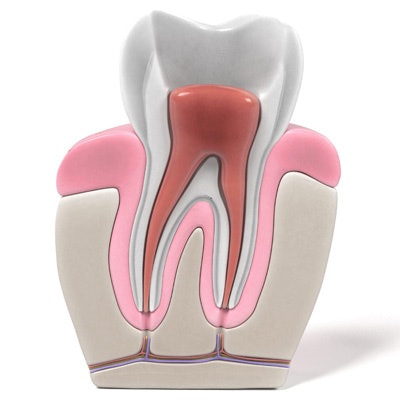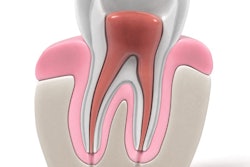
When endodontic retreatment is needed, is using a reciprocating or rotary instrumentation system a better option? Research has produced conflicting results. To learn more, a new randomized clinical trial examined how the use of these instruments for retreatment affects postoperative pain.
The researchers randomly assigned patients who required endodontic retreatment to undergo root canal procedures with either reciprocating or rotary instruments. They evaluated postoperative pain and medication use in both groups and found that the results were similar.
"The reciprocating system and the continuous rotary system were found to be equivalent regarding the incidence, intensity, duration of postoperative pain, and intake of analgesic medication," the authors wrote (Journal of Endodontics, May 3, 2017).
The lead study author was Daniel Comparin, DDS, of the department of endodontics at the Grande Rio University School of Dentistry in Rio de Janeiro.
How much does it hurt?
Some studies have shown that single-file reciprocating techniques are as effective as multifile retreatment rotary systems for gutta-percha and sealer removal, even though reciprocating systems were not originally designed to remove root filling materials. Research and clinical use of reciprocating systems for root canal retreatment continue, although concerns remain about their use. These include the amounts of dentin chips, irrigants, remaining pulp tissue, bacteria, and their byproducts that may be extruded into periradicular tissues, the authors wrote.
During root canal retreatment procedures, these and other products tend to extrude into periradicular tissues. This extrusion has been linked to periradicular inflammation, postoperative pain, flare-ups, and delayed periapical healing, they explained. However, most but not all studies have demonstrated less debris extrusion with reciprocating systems. Whether the use of a reciprocating system for endodontic retreatment affects postoperative pain has not been studied, according to the authors.
Therefore, the researchers conducted a prospective randomized clinical trial to investigate the influence of rotary or reciprocating retreatment techniques on the incidence, intensity, duration, and type of postoperative pain. They studied 65 adult patients who presented for endodontic retreatment at the department of endodontics at Grande Rio University from January to June 2015.
Patients were assigned to retreatment with the either VDW's Mtwo rotary instrumentation system or the Reciproc reciprocating system. The same endodontic specialist performed all treatments during a single visit.
In all cases, patients received local anesthesia of lidocaine with 1:100,000 epinephrine. The endodontist isolated the tooth undergoing treatment with a rubber dam and removed the old coronal restorations.
For both groups, a specific retreatment protocol was followed. This included removing gutta-percha root fillings with either Mtwo retreatment files with size/taper of 15/0.05v and 25/0.05v or R25 files 25/0.08v in the Reciproc group with an in-and-out pecking motion not to exceed 3 mm in amplitude. The endodontist then used an apex locator (Novapex, Forum Engineering Technologies) using #10 K-files to establish a working length 1 mm short of the apical foramen.
The endodontist removed the instruments from the canal and cleaned them if they failed to reach the working length after three strokes, then used them again up to the working length. Root canal preparation was performed with Mtwo instruments 30/0.05, 35/0.04, and 40/0.04 or with an R40 file in the Reciproc group.
Patients were told that they might experience pain afterward. They were called 24, 48, and 72 hours after treatment by an individual who was blinded to their treatment group and asked about their incidence, duration, and intensity of pain, as well as analgesic use.
Before treatment, almost half (49.2%) of the patients reported feeling pain. The patient's pain reduction progression after treatment is shown in the table below. Three patients in the rotary group and two in the reciprocating group postoperatively used ibuprofen during the first 24 hours.
| Patient's pain reduction progression after treatment | |||
| Pain level | After 24 hours | After 48 hours | After 72 hours |
| No pain | 62% | 83% | 95.4% |
| Mild pain | 30.1% | 16.9% | 4.6% |
| Moderate pain | 7.9% | 0% | 0% |
The researchers found no difference in the amount of postoperative pain experienced or the frequency and quantity of analgesic medication used postoperatively between the treatment groups.
However, the incidence of pain was significantly greater 24 hours after treatment in patients who experienced preoperative pain. Pain duration was significantly longer for men compared with women regardless of the treatment technique used.
"Because no statistically significant difference was observed between the groups, it can be suggested that the instrumentation systems used in the present had no influence on postoperative pain during endodontic retreatment procedures," the authors wrote.
Pain is the same
The authors attributed the low pain rates in the study to the method of transoperative care in both treatment groups. The instruments were used in a slow in-and-out pecking motion, with careful canal disinfection and file cleaning after three movements to prevent dentin chip accumulation. Additionally, the endodontist who performed the procedures followed a specific irritation protocol, which further reduced the possibility of debris accumulation and extrusion.
At the same time, the authors acknowledged that studying pain is subjective, each person's pain threshold is unique, and postendodontic pain is multifactorial.
"Both protocols can be applied to promote better disinfection during endodontic retreatment, resulting in treatment predictability concerning short-term follow-up regarding postoperative pain," the authors concluded.



















